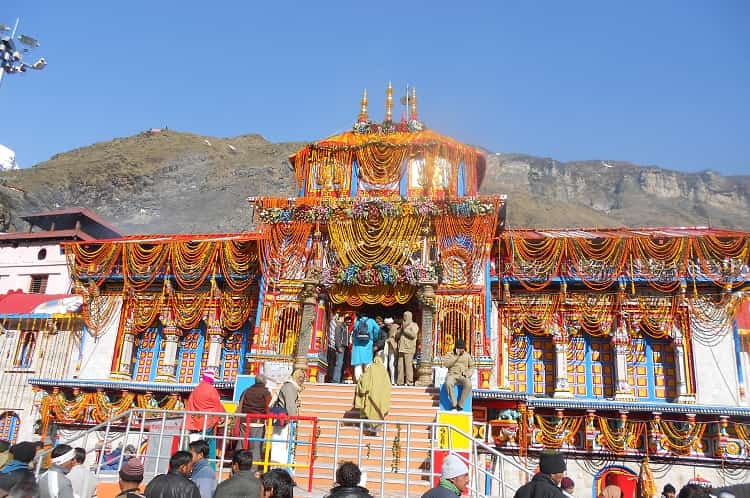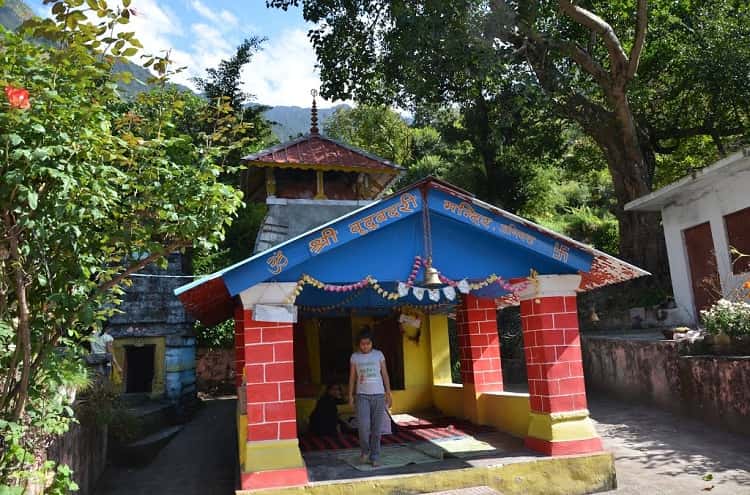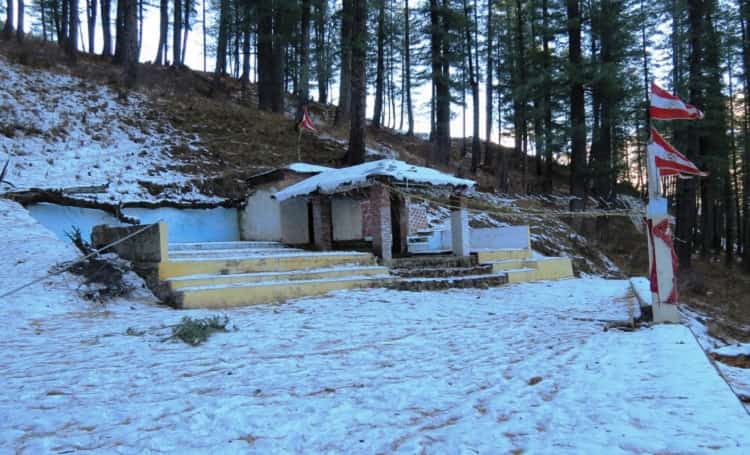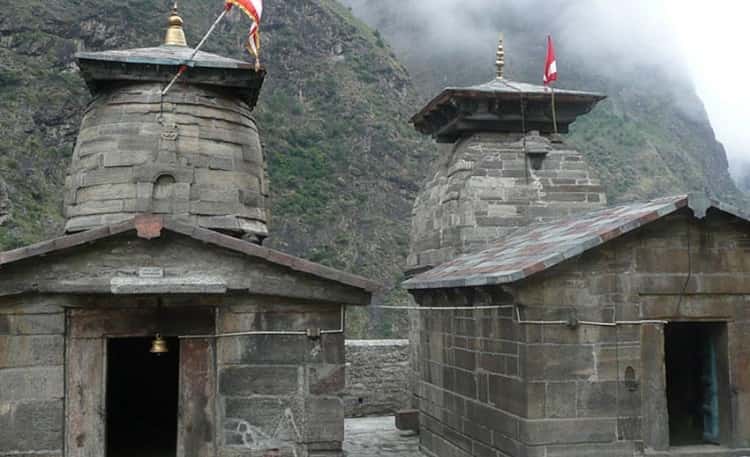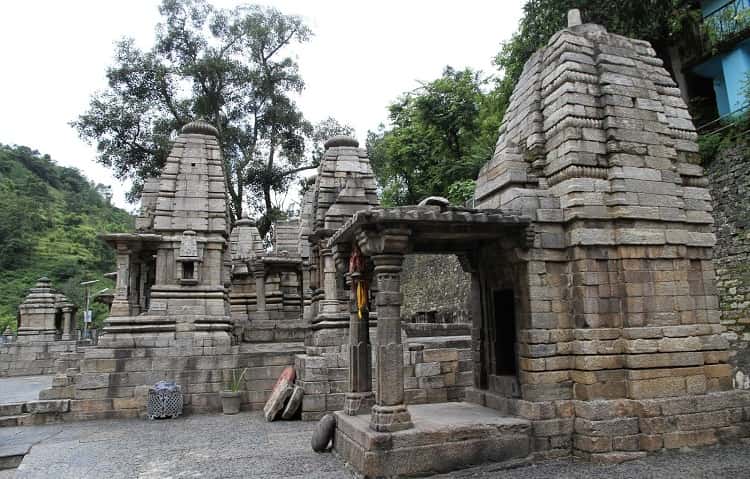No products in the cart.
That Badrinath forms part of a larger pilgrimage circuit that celebrates Lord Narayan’s infinite grace in a myriad of His forms is not known to all. In fact, River Alakananda, the hydrological Mother of Maa Ganga, flourishes the Himalayan land that lay between her origins at Satapanath and her merger with Nandakini at Nandprayag as the abode of Lord Narayan on earth. This holy tapovan of Badrikshetra, sacred ground, holds in her landscape multitude of Vaishnavite shrines, of which the prominent seven came to be collectively known as Sapt Badri. Five of the seven abodes of Lord Vishnu are preferred more in the whole conglomerate, causing recent years to further deduct it to ‘Panch Badri’. Before your curiosity goes wild over their sharing the common etymological ‘badri’ in all their names, let us tell you of how in ages bygone the path to the major Shrine at Badrinath meandered through a Badri van, forest of berries, causing all the seven temples to be suffixed with ‘Badri’ to imply their common spiritual thread. Let us then begin, by evoking the very grace of Lord Narayan Himself, to help you further in your heart’s call to go visit Panch Badri. What better place to begin that in treading along the sacred narratives of Vishnu Purana, Skanda Purana, Mahabharata and Bhagavata Purana, to illumine ourselves of how these sites became strung together as a single pilgrimage trail a Vishnu devotee ought to not miss in his lifetime.
Mythical History of Panch Badri as per Puranas
The Puranas cite Nar-Narayan as the deity pair incarnating Lord Vishnu’s divine essence upon earth. One might be familiar with the duo’s rather dramatic reincarnation as Lord Krishna and Arjun in the Dwapara yuga. Eons before then, they are said to have lived in the Himalayas, as the sons of Dharma, Righteousness. They engaged in ascetic spiritual practices intended to bring greater good to all living beings upon earth. In their search to pinpoint the ideal spot for building their hermitage as to enable the preparation of the holy ground that can hold the intense spiritual energy that would descend upon earth as a result of their sincere penances, they meditated at each of the four badris. Their search culminated at the fifth Badri, Vishal Badri temple at Badrinath, wherein, as legends would have it, their spiritual revival persisted for thousands of years. The land, refined holier because of its having served as the spiritual container for such austere spiritual mission, continues to attract thousands of pilgrims to breathe in its holy air. That’s the history of Panch Badri, as cited by the Puranas themselves.
Badrinath:
Skanda Purana elevates Badrinath temple to be holier than all the shrines that exist upon heaven and hell. Adi Shankaracharya discovered the presently worshipped Shaligram idol of Badrinarayan from the waters of Alakananda and established the present temple in this area, venerated as abounding in spiritual treasures as per many Puranas. In fact, Badrinath temple shares its stature as a ‘dham’ in both the char dham pilgrim circuits – the larger pan-Indian one, as well as the shorter Himalayan one.
How to Reach:
One can easily find State-government and private agency operated buses that ply till Badrinath from all major cities in the region – Delhi, Haridwar, Joshimath, Rishikesh to name a few. Alternatively, you may also avail experienced taxi driver services to take you till the shrine freeing you from having to navigate the trip’s perils alone.
If you choose to reach Badrinath as per a Chardham Package by Helicopter, your journey that begins with Sahastradhara helipad in Dehradun would culminate after an hour in Badrinath Helipad. One can easily rent a car for the one km stretch from the helipad till the temple and also ensuring you get to enjoy a blissful darshan employing VIP passes, the cost of which is included at least as per own Yatra package.
Best Time to Visit:
The temple opens its doors to devotees in between May and November, only during the summer months. The monsoon season (mid June till August) is better to be avoided owing to the unexpected difficulties heavy downpour causes in the hilly terrain. If you prefer a rather less crowded journey, avoid the heavy pilgrim season during the months of May and June.
Places to See:
Badrinath region has many sites of mythical, ecological and religious importance in the vicinity of its temple. This includes the Mana village with its famous Bhim Shila, Vyas Gufa and Saraswati river, the breathtaking Vasudhara falls accessible after a 3 km trek from the village and, of course, the holiest of holy Tapt kund, whose water is venerated as much for its healing properties as for its sacred essence.
Bridha Badri
Free from the typical ostentation associated with many pilgrimage sites, Vridha Badri lay perched at an altitude of 1380 m above sea level, in the beautiful and serene Himalayan village of Animath. One might rather be astonished to know that Lord Vishnu worshipped in this shrine is in the form of an old man, in memory of how he appeared to sage Narada bearing fruits for his intense sandhana performed here eons ago. In fact, temple mythology credits Viswakarma, famed to be the Divine craftsman, behind the beautiful craving of the idol of Badrinarayan installed in the temple. Again, Adi Shankaracharya is associated with its mythology too. The partially spoilt image was recovered and reinstated by the Acharya Himself well before his establishing the chief Badri temple at Badrinath.
How to Reach:
Vridha Badri falls en route one’s trail from Joshimath to Badrinath Temple. It is a mere 7 km journey from Joshimath on the path. One can easily include this in the char dham itinerary. The nearest railway station lies at Rishikesh, while Jolly Grant near Dehradun is the closest airport. Joshimath is well connected to both these centres.
Best Time to Visit:
The temple opens throughout the year, but the best time to visit it would fall in the Badrinath pilgrim season itself (May-November).
Bhavishya Badri
An even more austere temple dedicated to Lord Vishnu’s fourth incarnation of Narsimha lies at Bhavishya Badri. Bhavishya Badri can be reached only by trekking. Motorable road runs from Joshimath till Saldhar (19 km), while the rest of the 6 km stretch can only be traversed by trekking. The trekking path runs through dense Himalayan forests characteristic of the hilly terrain. The trek towards Bhavishya Badri culminates in the village of Subhain. In fact, local mythology cites the path to have once led till Mount Kailash and Mansarovar along the course of the beautiful Dhauli Ganga River.
Bhavishya Badri rests itself upon a rather fearful premonition. As per it, the present abode of Badrinath would inevitably be destroyed akin to how everything material passes through the cycles of creation-destruction. After the Nar and Narayan mountains housing the sacred Badrinarayan’s shrine would block the paths that lead till the temple, an ensuing destruction of the entire world would be followed by the enshrinement of Badrinarayan at the Bhavishya Badrinath Temple. Thus, Bhavishya Badri is revered to be the future abode of Lord Badrinarayan after the collapse of the world and the present Badrinath shrine.
Yogadhyan Badri
As its name suggests, what the shrine offers is a spiritually conducive atmosphere for one to descend deeper into meditation. For even the idol of Vishnu worshipped at the site is in a meditative state, having been placed by Raja Pandu, father of Pandavas, who attained moksha after his death in the same spot. In fact, this is also where Pandavas handed over their hard-won kingdom from Kurukshetra war into the hands of their grandson Parikshit following their inner pull to renounce the material world and perform penances to free themselves of their karmic imprints earned during the bloody war. The life size idol of Lord Vishnu evokes a resonant meditative state in the devout heart worshipping at this shrine too. Also, Yogadhyan Badri boasts itself of being as ancient as Badrinath itself. The steep descent of steps from the road till the temple on the banks of the mighty Alakananda River emulates the inner depth the quietude and spiritual serenity the temple inspires in a devout heart.
How to Reach:
Since the Temple falls along the motorable road that lead to Badrinath, one can instruct one’s driver to include the Yogadhyan Badri in your itinerary. Pandukeswar village that houses the deity is at a distance of 21 km from Joshimath. One will have to descend half a kilometer from the height to reach the temple.
Adi Badri
The ancient shrine at Adi Badri lies beyond Karnaprayag, the mesmerizing confluence of River Pindar and River Alaknanda. In fact, a cluster of 16 shrines occupy this 17 km of the hill ranges in the region, of which the construction of seven is attributed to Gupta Period. In fact, the enshrinement of each of these temples is credited to Adi Shankaracharya. It was at this site that worshippers of earlier days prayed to Lord Vishnu at, when doors of Badrinath were closed during the wintry days.
This rather small temple is constructed over an elevated platform with a pyramidal enclosure. The 1 m long idol built of black stone represents Lord Vishnu holding lotus, chakra and mace in his many hands.
The temple mythology of Adi Badri cites that the temple served as the abode of Badrinarayan during Treta, Dwapar and Satya Yuga. While Kaliyuga will have Badrinarayan stay at Badrinath, Badrinarayan would shift to Bhavishya Badri with the end of the Yuga nad ushering in of another cycle of Satya yuga, rendering the shrine at Adi Badri as Yog Badri.
How to Reach:
The beautiful shrine falls on the way to Ranikhet from Karnaprayag. There are well-built roads connecting Adi Badri with Karna Prayag, Nainital Ranikhet and Ramnagar. The 19 km distance from Karnaprayag till the shrine can be easily covered within an hour.
While one can pay obeisance at Badrinath travelling by helicopter, know that all the other shrines that form part of Panch Badri can be accessed only by road; while the vehicle can take you till some of the temples, those at Dhyan Badri and Bhavishya Badri demands an enduring trek from the pilgrim.

